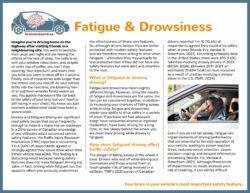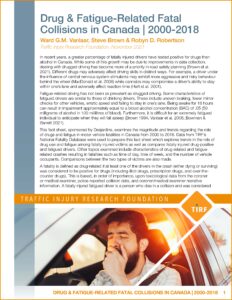Fatigue & Drowsiness
Imagine you’re driving home on the highway after visiting friends in a neighbouring city.
You went to bed later than usual last night and are feeling the effects of the lack of sleep. The radio is on with your window rolled down, and despite an extra cup of coffee, you can’t stop yawning. Your eyes burn, and every time you blink you seem to dose off for a second. Finally, one of those blinks lasts longer than the others, and you nod off. As your vehicle drifts into the next lane, the booming horn of an eighteen-wheeler finally wakes up you. You quickly manoeuvre the car back to the safety of your lane, but your heart is still racing in your chest. You know you just narrowly avoided what could have been a severe crash.
Drowsy and fatigued driving are significant road safety issues that occur frequently enough to make it a major risk on roadways. In a 2016 survey of Canadian knowledge of and attitudes about advanced vehicle safety features, the Traffic Injury Research Foundation (TIRF) reported a concerning 1 in 4 (24%) of respondents agreed or strongly agreed they would drive when tired if their vehicle had ADAS. This finding is a disturbing result because having safety features does not make fatigued driving any safer; in fact, driving while fatigued has the opposite effect and seriously undermines the effectiveness of those very features. So, although drivers believe they are better protected with modern safety features – and are therefore more willing to drive when fatigued – ultimately, they may actually be less protected than if they did not have any safety features but were alert and attentive to the road.
What is fatigued or drowsy driving?
Fatigue and drowsiness mean slightly different things. However, since the results of fatigue and drowsiness are the same, the two can be considered together. In addition to increasing your chances of falling asleep while driving, fatigue and drowsiness impair your ability to drive safely in a variety of ways. If you have not had adequate sleep; have consumed alcohol or ingested medication; have been driving for a long time; or, feel sleepy behind the wheel, you are most likely driving while drowsy or fatigued.
How does fatigued driving affect traffic safety?
The danger of falling asleep at the wheel is clear. Drivers who nod off while driving put themselves and those around them at much greater risk of being involved in a collision. TIRF’s 2021 survey of Canadian drivers reported 1 in 10 (10.6%) of respondents agreed they could drive safely when drowsy (Woods-Fry, Vanlaar & Robertson, 2021). According to fatality data in the United States, there were 693 (1.6%) fatalities involving drowsy drivers in 2022 (NCSA, 2024). Between 2017-2021, an estimated 29,834 fatalities have occurred as a result of crashes involving a drowsy driver in the U.S. (Tefft, 2024).
Even if you do not fall asleep, fatigue can impair elements of driving performance that are essential to the safe operation of your vehicle, leading to slower reaction times, reduced overall attention, slower decision-making, and delayed information processing (Woods-Fry, Vanlaar & Robertson, 2021). Although these kinds of impairments no doubt increase your risk of crashing, it can still be difficult brainonboard.ca
to pinpoint which crashes are actually caused by fatigue. Measuring the causal role of fatigue is challenging for a couple of reasons. People are not very good at gauging their level of fatigue (Vanlaar, Brown & Robertson, 2021). As such, drivers may under-report their frequency of driving when tired. In addition, fatigue is difficult to directly observe in traffic and may not always be noted in crash reports. In Canada, data show 5% of all fatal crashes from 2014- 2018 involved a drowsy driver (TIRF, 2024). Comparatively, data show an estimated 17.6% of all fatal crashes in years 2017–2021 involved a drowsy driver in the U.S. Among drivers involved in these crashes, 3.1% were sleepy or asleep (Tefft, 2024).
Are there laws against fatigued driving?
Although it is acknowledged that driving while fatigued is dangerous, there is no specific law targeting fatigued driving. It is challenging to determine if fatigue was a factor in a crash or to measure fatigue on the roadside. In addition, it is not always easy for drivers to tell when they themselves are fatigued, and it is equally difficult for crash investigators to measure the influence of fatigue in crashes.
In Canada, laws such as driving without due care and attention or reasonable consideration for other motorists or people on the road include fatigued driving. Each jurisdiction has its own penalties with fines starting at about $400 with jail terms of up to six months depending on the charge.
There are currently few laws in the US that target fatigued driving specifically. The state of New Jersey’s Maggie’s Law makes drivers liable for vehicular homicide if they have been awake for more than twenty-four hours and are in a crash that results in a fatality. Violation of this law carries a maximum prison sentence of ten years and a $100,000 fine. This law was passed in 2003, after a 20-year-old college student was killed by a driver who had fallen asleep at the wheel after being awake for over thirty hours (Reuters US, 2007). Similarly, Arkansas law makes drowsy driving a form of negligent homicide if a driver caused a fatality after going 24 hours or more without sleep. Fatigue may also be used to demonstrate negligence in civil actions arising from accidents that resulted in injuries (Varagur 2017).
How many motorists drive while fatigued?
According to the E-Survey of Road Users’ Attitudes (ESRA, 2024), nearly 1 in 5 (18.7%) of Canadian drivers have driven when they were so tired they had trouble keeping their eyes open. The large number of drivers who reported even occasional fatigued driving is concerning, particularly because, in some cases, fatigue is comparable to alcohol intoxication. Studies show that a person who has not had proper rest in over 17 hours is equivalent to a person with a blood alcohol concentration (BAC) of .05, which results in a roadside suspension from police. Sleep deprivation for a full day results in a BAC of .10, which is legally impaired (Tefft 2016, Stutts et al. 1999).
Even more concerning, 60% of American adults reported they have driven while drowsy despite 97% of American adults reporting drowsy driving is extremely risky (National Sleep Foundation, 2023).
Who is most likely to drive while fatigued?
Anyone who has not had adequate sleep or who has been driving for a significant amount of time without breaks can be prone to fatigue. Generally, however, fatigued drivers share some common characteristics:
- Young drivers are more likely to drive while fatigued (NHTSA 2017). Almost one in six (16%) of teen drivers, ages 13-17, reported driving while drowsy (National Sleep Foundation, 2023). Fatigued drivers are most likely to be male (Zeng et al., 2020; Rezapour & Ksaibati, 2022; Alquarshi et al., 2024).
- Fatigued drivers are more likely to report having inadequate sleep. In general, they report sleeping less than eight hours and are likely to describe their sleep quality as poor (Sprajcer et al., 2023; AAAFTS, 2023; NHTSA, 2023).
- Fatigued drivers are more likely to be driving between the hours of midnight to 6 a.m. and late afternoon. These hours correspond to the sleepiest times of our biological sleep cycles (Caponecchia & Williamson 2018 , TIRF 2012).
- Fatigued drivers are more likely to work shifts that take them off of a normal sleep rhythm, (e.g., night shifts or irregular shifts) (Dalziel & Job 1997; Marcus & Loughlin 1996; McCartt et al., 1996).
In addition to the characteristics shared by fatigued drivers, fatal crashes also have some common features:
- Typically, these crashes occur at night or mid-afternoon (TIRF, 2016; Stutts, 1999).
- They more commonly involve a lone occupant rather than a vehicle with two or more occupants (TIRF, 2016).
- Fatigued driver crashes normally involve a single vehicle running off the roadway or a head-on collision, often without any signs of braking (Stutts, 1999).
- Fatigued driver crashes usually occur on higher-speed roads, such as highways (NHTSA, 2023).
How does fatigue affect my ability to benefit from my safety features?
Fatigue can have serious implications for the effectiveness of vehicle safety features. In the most serious cases of fatigue where you actually fall asleep, any benefit you would have from safety features such as ABS, brake assist, adaptive headlights, and electronic stability control is effectively eliminated. This is because such safety features – no matter how technologically advanced – are not a substitute for your eyes. Most active safety features do not have any way of watching the road for you, and work only based on your braking and steering actions. Clearly, if you are asleep, you cannot provide braking or steering information.
Even if you manage to stay awake, fatigue has effects that can undermine the safety features of your car. Your reaction time slows down, you cannot process information as quickly, decisions take longer to make, and your overall ability to get a sense of what is going on around you is impaired or reduced. The more tired you become, the more you remove yourself from the act of driving. Relying on safety features to do the driving for you is a dangerous risk, since these features are not designed to replace you, and cannot be safely relied upon to be your substitute in any regard.
What kinds of vehicle safety features are directly affected by fatigue?
Fatigue has direct implications for many vehicle safety features. To illustrate, your reduced alertness may cause you to brake more slowly for an obstacle. This impairment will affect brake-specific features like ABS, electronic brake-force distribution, and brake assist, and may result in not stopping in time to avoid a collision. Safety features that help you brake are of little or no benefit if you brake too late or fail to apply the brakes at all. In a similar situation, fatigue may delay your ability to recognize an obstacle in the road. Swerving more quickly to avoid this obstacle could make it impossible for electronic stability control – one of the most effective safety features – to stabilize your vehicle and prevent a rollover or loss of control.
Driver assistance technologies like adaptive headlights are also be negatively affected by fatigue. Smart headlight technology highlights objects in your path that you would not normally have seen, but you still have to react appropriately to any obstacles or hazards that are illuminated. The ability to take quick avoidance action is hindered by the effects of fatigue. So, although your adaptive headlights help you to see upcoming hazards, you may still be unable to avoid them due to the impairing effects of fatigue.
Even technologies like advanced collision warning and lane departure warning that sound alarms or indicators of impending collisions or movement out of your lane are limited by driver fatigue. Both safety systems have design limitations that prevent the indicators from going off in certain cases. For instance, advanced collision warning systems are designed to look for large, metallic objects (i.e., another vehicle), and may not sound an alarm for a cyclist or pedestrian. Similarly, lane departure warnings only work on roads where the lanes are marked clearly. In cases where the warnings do not sound, driver fatigue may easily lead to a collision.
When the warnings do go off, fatigue may still result in slower braking, harder swerving, and an overall decline in your ability to safely avoid collisions. Unlike an alert driver who has their eyes on the road, warning systems are unable to get the bigger picture of what is happening on the road. They cannot notice potential hazards far ahead or on the side of the road.
Where can I find out more information about fatigued driving?
Every year, TIRF publishes the Road Safety Monitor (RSM), a survey designed to gauge public opinion on a range of key road safety issues. In 2016, TIRF released an RSM dedicated to the issue of knowledge of vehicle safety features in Canada. In addition, in 2021 TIRF published a report detailing drug and fatigue-related fatal collisions in Canada from 2000-2018. Drowsiness and fatigue are also topics of much of TIRF’s current research. Many of the facts, statistics, and research in this document are pulled from these TIRF publications. You can access these reports, previous reports, and other TIRF publications on this website or by visiting the TIRF website at tirf.ca.
Fatigued driving has also been the focus of research and publications by Transport Canada. Their findings can be found at www.tc.gc.ca. In addition, the National Highway Traffic Safety Administration (NHTSA) in the United States has researched the effects of fatigue and drowsiness on driver safety. Results of this research can be located by visiting their website at www.nhtsa.gov.
Visit brainonboard.ca/programresources/references for a full list of references.
Related Videos
Play Video




